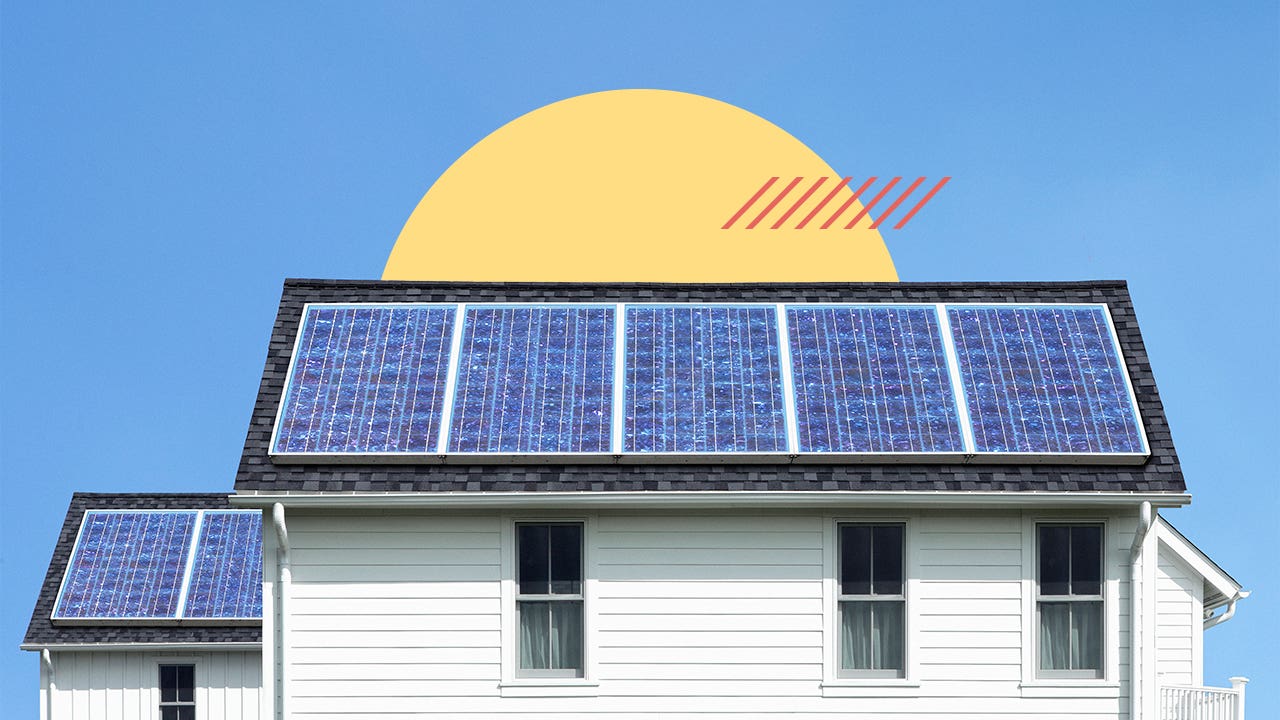Guide to energy efficient homes




As climate change becomes more of a problem in the United States and globally, having a green home is becoming more desirable. According to the National Association of Realtors (NAR), there has been a notable increase on the market of homes with energy-efficient features, like solar panels, as homeowners try to reduce their environmental impact.
If you are thinking about upgrading your home with green features, here’s everything you need to know — including which improvements can increase the value of your home and how to find your Home Energy Score.
Key takeaways
- Homeowners can increase their home’s value by adding energy-saving features such as solar panels.
- If you’re shopping for an energy-saving home, things to look for include green features, an efficient design and good insulation.
- You can also make your existing home more energy-efficient by switching to smart thermostats, LED light bulbs and energy-saving appliances.
Energy-efficient home data
Energy-saving homes are becoming more common, and buyers are making green features a priority during their search. Here are some statistics around energy-efficient homes, including those certified as LEED (Leadership in Energy and Environmental Design), a widely used ratings system from the U.S. Green Building Council.
- NAR’s 2023 Realtors and Sustainability Report found that half of agents and brokers have helped a client buy or sell a property with green features during the past 12 months.
- LEED-certified homes use an average of 20 to 30 percent less energy than traditional homes, with some reporting up to 60 percent in energy savings.
- Homeowners who install solar panels can save a lot on electricity — between $20,000 and $97,000 over the lifetime of the panel system.
- According to the 2022 Global Sustainability Study, 89 percent of consumers have made changes to become more sustainable in their purchasing habits.
- Several tax credits and rebates are available for eco-conscious homeowners thanks to 2022’s Inflation Reduction Act. The law provides financial incentives covering everything from purchasing energy-efficient appliances to undertaking energy-efficient home retrofits, including the installation of solar panels.
Energy-efficient home checklist
If you are considering an energy-efficient home, there are a variety of things to look out for. Here are some of the biggest ones:
- Size of the home: In most cases, larger homes are less efficient because they take more energy to heat and cool. Plus, big houses often have more lights, appliances and other features that require energy.
- Green features: Look for homes that are already equipped with eco-friendly features. Examples include solar panels, heat pumps for heating and cooling, Energy Star–certified appliances and a rainwater collection system.
- Building design: The design and layout of a home can impact how energy efficient it is. For example, open concept houses are often more efficient than homes that are broken up into smaller rooms, because it’s easier to control the temperature and requires less building materials to construct.
- Insulation: Look for homes that are well-insulated to keep the house warm in winter and cool in summer. Spray-foam insulation is widely considered to be the most energy-efficient type.
- Doors and windows: Efficient and well-sealed doors and windows can reduce heating and cooling costs. For improved efficiency, you can also install window shades to reduce cold drafts in the winter and keep heat outside in the summer.
- Energy sources: Some homes rely partially or entirely on renewable energy sources, like solar. Homes with solar panels might be more expensive, but they can reduce your energy bill considerably. Some states offer incentives for homeowners with solar.
- Indoor environment quality: Having a good ventilation system can improve the efficiency of your home while reducing the amount of indoor pollution.
- Landscaping: Look for homes with drought-tolerant plants, especially in dry regions that don’t get much rain. Some examples of drought-tolerant plants include lavender, rosemary, aloe and geraniums.
Energy-efficient homes don’t just reduce the cost of heating, cooling and electricity. They also positively impact the environment. When your home requires less energy, it frees up important resources, like water, and reduces reliance on commercial building materials, which often generate large amounts of greenhouse gasses.
Energy-efficient home sales
A home’s energy-efficiency isn’t just important while you’re living there. Certain green home features can also increase the value of your home when you get ready to sell it.
Homebuyers will continue to value energy-efficiency as a way to save money.— Greg McBride, Bankrate Chief Financial Analyst
“With energy costs — heating and cooling in particular — being a key line item in the household budget, homeowners and homebuyers will continue to value energy-efficiency as a way to save money,” says McBride.
NAR’s 2023 Generational Trends Report looked at the energy-efficiency features homebuyers found to be the most important. Efficient heating/cooling and windows/doors/siding were the top rankers, with 31 and 28 percent of buyers saying they were important. After that, 22 percent of buyers wanted energy-efficient lighting, 20 percent were looking for energy-efficient appliances and 11 percent wanted landscaping for energy conservation.
For homeowners interested in transitioning to energy-efficient appliances, the Inflation Reduction Act provides some $9 billion in consumer energy rebate programs. And if you’d like to increase the efficiency and resale value of your home by adding solar panels, it can help there too. There’s a 30 percent tax credit included in the measure to help offset the cost of installing solar panels and battery storage systems. The measure also includes consumer tax credits designed to make expenses such as heat pumps, electric HVAC systems and water heaters more affordable.
“For existing homes that are not energy-efficient, the upfront cost of improvements is often an obstacle, but the existence of tax credits can be an incentive,” says McBride.
Home Energy Score: What is it, and how can it help make your home greener?
Wondering how to make your home more energy efficient? Start by getting your Home Energy Score. This scoring system, provided by the U.S. Department of Energy, reflects the current efficiency of your home based on energy use and associated costs. The DOE equates it to a miles-per-gallon rating for a car, but for your home. Scores are on a scale of one to 10, with 10 being the most efficient. You can enter your zip code online to find a qualified assessor to score your home.
Key terms
- Home Energy Score
- Developed by the U.S. Department of Energy, this score rates a home’s energy-efficiency on a scale from 1 (least efficient) to 10 (most efficient).
When the evaluation is complete, you receive not just a score but also a comprehensive report from the assessor that breaks down your energy usage and provides suggestions for improvement. However, keep in mind that Home Energy Scores are mostly for your own benefit. The main purpose is to help you save money by making strategic green improvements.
Energy-saving upgrades
Here are a few green home improvements that can have a significant return on investment:
| Upgrade | Savings |
|---|---|
| Energy-efficient appliances | Energy-efficient home appliances, including washers and dryers, dishwashers, refrigerators, water heaters and air conditioners, use 10 to 50 percent less electricity than traditional models. If you are already considering getting new appliances, it might be worth the slightly higher cost of a green model. |
| Smart thermostat | Smart thermostats make it easier to control the temperature in your home all year long. You can also control the temperature remotely, so you don’t waste money on heating and cooling when you’re not home. On average, a smart thermostat can save you 8 percent on your annual heating and cooling bills. |
| LED bulbs | Consider replacing the traditional light bulbs in your home with LED or energy-efficient versions. According to the U.S. Department of Energy, the average household saves roughly $225 in energy costs each year by switching to LED bulbs. |
| Low-flow fixtures | Water usage is a big part of energy efficiency. To lower usage and save money, think about replacing plumbing fixtures with low-flow options, including low-flow toilets, shower heads and sink faucets. An average family can save about 700 gallons of water per year by switching to low-flow faucets, according to the Environmental Protection Agency. |
| Ceiling fans | Installing ceiling fans can save money on cooling your home in the summer. They are very inexpensive compared to whole-house air conditioning systems, and even if they don’t do the whole job, they can make you less reliant on expensive AC. |
FAQs
-
Green buildings, such as those that are LEED-certified, are designed and built to reduce energy and water usage, and improve efficiency over typical buildings. They have a smaller impact on the environment and can be better for human health. Both residential homes and commercial buildings can include green features, such as solar panels, low-flow plumbing fixtures and energy-efficient heating and cooling systems.
-
Renewable energy is any source of energy that is not fully depleted once it’s used, or replenishes itself at a faster rate than it is consumed. Common examples of renewable energy for the home are solar and wind power, which continue to generate as the energy is being consumed. Fossil fuels like oil are not considered sources of renewable energy.
-
Common ways to reduce energy consumption in your home include installing energy-efficient appliances, putting solar panels on your roof and using a smart thermostat to control the temperature in your home. You can also make small lifestyle changes to reduce your energy usage, such as taking shorter showers, turning off lights when you leave a room and unplugging electronics when they are not in use.
-
Solar energy harnesses the sun’s rays to create electricity. Sunlight on a solar panel or cell gets converted into electrical energy, which can be stored in a battery or used to power appliances and devices in your home. Even on cloudy days, solar panels generally continue to convert energy from sunlight, but at a slower rate.
You may also like


How often can you refinance your home?



